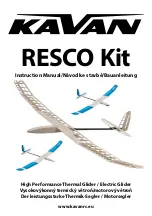
NOSE WHEEL
STEERING SYSTEM
GENERAL
The digital nose wheel steering (NWS) system
is a steer-by-wire system that provides nose
wheel deflections up to a maximum of 60 de-
gree left or right for maneuvering the airplane
on the ground. The system provides variable
steering authority based on the airplane’s
groundspeed and rudder pedal inputs by the
crew. A steering command based upon pedal
position and force, nose strut position, and
aircraft speed is calculated by the NWS con-
troller (computer). This command is relayed
to a DC motor (servo actuator) on the top of
the nose strut, which positions the nose wheel
via a nose wheel strut gearbox.
System components (Figure 14-24) consist of
a nose wheel steering controller (computer),
steering servo actuator and a gearbox, two po-
sition sensors (RVDTs) on the gearbox, two
rudder pedal position sensors (RVDTs), two
dual redundant rudder pedal force sensors,
and a NOSE STEER switch/indicator located
on the GEAR/HYD control panel. The sys-
tem also includes a dual switch nose landing
gear squat switch mechanism, which provides
nose WOW signals to the NWS computer
(Figure 14-24).
The nose wheel steering computer is a dual mi-
croprocessor, comprised of a Command
Channel and a Monitor Channel. Both chan-
nels provide failsafe operation of the NWS
system by removing power from the servo ac-
tuator in the event that incorrect operation or
failure is detected.
The NWS system is powered with 28 VDC
through the 25 amp MOTOR circuit breaker
and a 2 amp CMPTR circuit breaker located
on the pilot’s circuit breaker panel.
The NWS system can be Armed and Disarmed
with the momentary action NOSE STEER
switch on the GEAR/HYD control panel. The
NOSE STEER switch will illuminate “ON”
when the following conditions occur:
• Both system DC power sources are avail-
able to the computer
• The nose gear is down and locked
• No system faults or failures are detected
Once Armed, engagement is possible when
WOW signals indicate the aircraft is on the
ground and information from the wheel speed
transducers is available. “Engaged” is de-
scribed as the operating mode of the NWS
system in which the system has been Armed,
power is applied to the Servo Actuator and nose
wheel movement is being controlled via the
NWS computer command. NWS engagement
is automatic when the system is armed and the
right conditions exist. Engagement is not an-
nunciated in the cockpit.
The NWS system can be Disarmed/Disengaged
by momentarily depressing the NOSE STEER
switch/indicator or either Control Wheel
Master Switch (MSW).
Two rudder pedal position sensors provide
pedal displacement information to the NWS
computer. Once a rudder pedal has reached full
travel, further nose displacement is generated
by additional force being applied to the rud-
der pedal. The pedal force sensors measure ten-
sion and compression forces in the rudder
linkage and feed this information to the NWS
computer through a Yaw Force Interface Box.
Force applied to the force sensors provides a
steering command that is additive to the rud-
der pedal position steering command. The
rudder pedal force sensors can, however, be ac-
tive before full travel is encountered, de-
pending on aerodynamic load on the rudder.
The NWS computer also uses information
from the four main wheel speed transducers
in computing nose wheel deflection. As
groundspeed increases, signals provided by the
wheel speed transducers decreases the maxi-
mum nose wheel deflection angle. The al-
l ow a b l e s t e e r i n g a u t h o r i t y i s i nve r s e l y
proportional to ground speed.
14-23
FOR TRAINING PURPOSES ONLY
L E A R J E T 4 5
P I L O T T R A I N I N G M A N U A L
FlightSafety
international
L E A R J E T 4 5
P I L O T T R A I N I N G M A N U A L
FlightSafety
international
















































